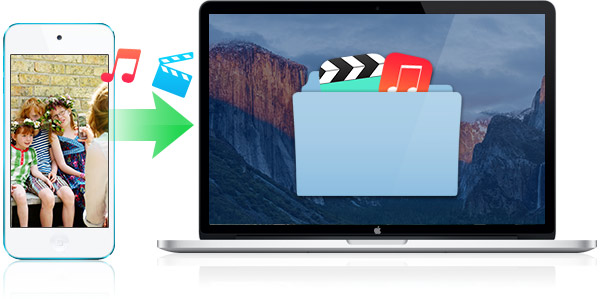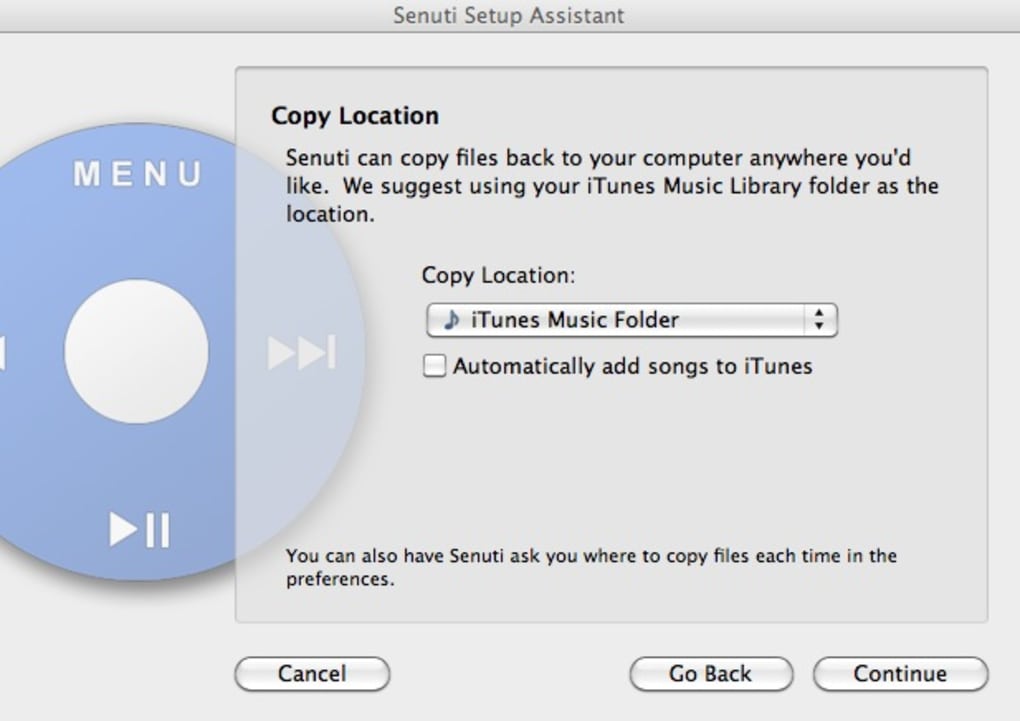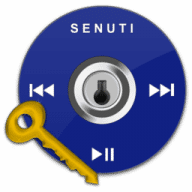
If you own an iPod, for sure you have ever wondered why you can't copy music from iPod to Mac, extract songs from your iPod. ITunes doesn't allow you to do that, but here we have the solution and its name is Senuti. It's very easy, once you run the program, you see the complete list of. Senuti 1.3.3 – Copy music from iPods to Macs. August 23, 2014 Senuti is a simple utility that makes transferring songs from an iPod to your computer quick and easy. Senuti for Mac 1.3.3. It's your music. Do what you want with it. Senuti is a simple utility that makes transferring songs from an iPod to your computer quick and easy.
iShowU Studio 2.0.2 Crack For Mac OSX Free Download
Here's the link to senuti:http://www.mediafire.com/?dzzdmzj3zny.

iShowU Studio 2.0.2 Crack For Mac OSX Free Download – This easy screen recording & editing on your Mac: that’s the core idea. Built from day one with this in mind, it’s easy to capture what you want; add text, annotations, pointers and highlights and then share your result. Features you’ve come to expect in the iShowU “series” have been supercharged: screen & camera capture, mouse highlighting and keyboard animations take on a new lease of life now that you can edit when and how they appear. Did we mention we’ve reworked uploading too? Take the best realtime capture, mix in “time” – and voila, iShowU Studio!
Senuti Mac Osx Software Nihuo Web Log Analyzer for Mac OSX v.4.04 Nihuo Web Log Analyzer is a powerful Mac OSX application that turns your web logs into a professional sales and prospecting tool. Sony Spectralayers Pro 4.0.63 Crack For Mac OSX Free Download. Sony Spectralayers Pro 4.0.63 Crack For Mac OSX Free Download- It can work with the individual sounds in an audio file just as if they were objects in a photograph.Make detailed repairs with precise tools. Microsoft office 2016 Mac crack Full Download 3 Comments June 14, 2017 PDF & Documents Ms office 2016 mac crack is Here to download for free and direct link, exclusive on 4MacSof.com.
Super fast full screen capture
Utilising the latest OS X technology and hardware accelerated goodness.
Simple editing interface
An uncluttered yet useful screen recording interface, with the editing tools you need directly accessible.
Full suite of Editing Tools
Super intuitive pan/zoom, shapes, fades and more. iShowU Studio lets you point out what’s important quickly and easily.

Free Senuti Download For Mac Full Version Free
Built specifically for screencasts
Mouse and keyboard visualization, audio annotations: just some of the tools tailored specifically for the creation of ‘screen based’ content.
Gorgeous “Full Screen” editing interface
Designed from the beginning to both operate and look fantastic when in full screen.
We love colour
iShowU Studio is aware of colour-tagged footage, giving you accurate results all the way from import, preview through to final render.
Share your creation
Get your result “out there”! The entire “share” panel focuses on what your end users need. Quicktime? No problem. Web? No problem! iDevices1? Yep! 1080p? Sure! YouTube, Vimeo as well? You got it!
Capture directly from iOS
Capture directly from your iOS device, create beautiful demos of your iOS apps with ease!
Built in Camera capture
Plug in any OS X compatible camera and capture footage from that in realtime. Or add it later, your call.
Requirements: Mac OS X Kodiak, Cheetah 10.0, Puma 10.1, Jaguar 10.2, Panther 10.3, Tiger 10.4, Leopard 10.5, Snow Leopard 10.6, Lion 10.7, Mountain Lion 10.8, Mavericks 10.9, Yosemite 10.10, El Capitan 10.11, Sierra 10.12 and later Version.
Screen Shoot:
Senuti for Mac helps you manage your media library by facilitating the transfer of music, movies, and podcasts from your iPhone or iPod back to your computer. Through this app, you can choose to add transferred items to iTunes, save them in a separate folder on your computer, or both.
Pros
Intro and instructions: When you first open this app, you'll be greeted with a brief walk-through that gives you an overview of what the program can do and also provides tips on how to avoid certain pitfalls. The interface is straightforward enough to begin with, but this added introduction lets you jump right in and start using the app without hesitation.
Nice interface and functionality: All options are clearly laid-out in this app's interface, and you can take advantage of some nice features, like the ability to drag and drop playlists directly into the program. Scan war completed quickly, and you can set certain preferences ahead of time, such as where you'd like to automatically save songs to, in order to save time each time you initiate a transfer.
Cons
Crashes and bugs: During testing, this app crashed every time we tried to select the Advanced Preferences tab in Settings. This probably won't be much of a concern to casual users anyway, although we were unable to learn what options were actually contained in that space. But more experienced users might be frustrated by the inability to fully customize the program to suit their needs.
Bottom Line
Senuti for Mac is a convenient and versatile program that gives you the ability to control more fully what and how you import media from your iDevice. The trial version is good for 30 days, but it has the additional limitations of a maximum of 1,000 songs transferred, and it will also pause for 30 seconds after every 10 songs. The full version costs $18.99.
Editors' note: This is a review of the trial version of Senuti for Mac 1.3.3.
What do you need to know about free software?
Follow the steps for Yosemite download form Mac Apps Store
OS X Yosemite was announced and released to developers on June 2, 2014, at WWDC 2014 and released to public beta testers on July 24, 2014. Yosemite was released to consumers on October 16, 2014. Following the Northern California landmark-based naming scheme introduced with OS X Mavericks, Yosemite is named after the national park.
- Sign in to the Mac Apps store after lunching the Mac Apps store starter file on the desktop or laptop.
- Then use the search bar for find the Yosemite download link and click the button to download when you found. To download Yosemite you must sign in to the Mac Apps store by using Apple ID username and password.
- The Yosemite file is 5GB of size. So, please choose a proper drive which has relevant free space to download the file.
- After you download the Yosemite download file it will automatically open for installing. Do not proceed with the auto installation process.
- What you have to do is, quit from the auto installation process and create a bootable USB drive with the Yosemite installer.
- After that you will be able to boot up the Mac PC using the USB bootable installer.
- Learn about the Yosemite installing by USB bootable process from video tutorials and websites and guide them to complete the process.
Yosemite download from our server links
This method we are providing Yosemite download links for direct downloading. Please guide the following description for install the Yosemite Mac OS X.
Installing method one for Yosemite.
You can install the Yosemite into an empty volume of your PC or laptop or you can erase a volume and install the Mac OS X Yosemite. Here you do not install the Yosemite in current start up volume.
Second method: download El Capitan and Clean Install on Startup Volume
This is the method which is using a USB installer to install the Yosemite. Most of the people use this method for install Mac OS X versions on their Apple devices. In this method, the Mac OS X Yosemite will be installed on the existing startup drive. After you create the bootable installer on your USB drive you can plug in it to the Mac PC or laptop and go through the steps to install the Yosemite installer file.
System Requirements for Mac OS X Yosemite
2 GB of RAM, 8 GB storage, OS X 10.6.8 Snow Leopard
Senuti For Mac Yosemite 2017

Compatible device models for Mac OS X Yosemite.
Mac Mini, MacBook, MacBook Pro 17-inch MacBook White and Black, MacBook Retina, iMac, MacBook Air, MacBook Pro 13-inch, MacBook Pro 15-inch, Mac Pro.
See the video guide.
How to create a bootable installer as startup drive for Mac OS Yosemite installing process.
You can download the Mac OS X Yosemite installer from the Mac Apps Store. Then you can start to create a bootable disk as a startup device with the Yosemite download installer. Please remember to use more than 12 GB of free space USB drive to use as a bootable installer.
Step one: – plug in the USB drive to the Mac PC (use a secondary internal partition for installing the files)
Step two: – open the terminal and use the createinstallmedia command to create the bootable USB installer.
Step three: – Enter the following path to the terminal

Note: – the Yosemite installer must be in the application folder to do this step.
Example: –
Note: – In this example, the Yosemite installer in the application folder and Myusb is the name of USB drive which is used to boot.
Download Yosemite ISO from Torrents.
Senuti Free Download
The Go menu in OS X Yosemite is chock-full of shortcuts. The items on this menu take you to places on your Mac — many of the same places you can go with the Finder window toolbar — and a few other places.
The following list gives you a brief look at the items on the Go menu:
Senuti Free
Back (Command+[): Use this menu option to return to the last Finder window that you had open. It’s equivalent to the Back button on the Finder toolbar, in case you have the toolbar hidden.
Forward (Command+]): This command is the opposite of using the Back command, moving you forward through every folder you open. Remember that if you haven’t gone back, you can’t go forward.
Enclosing Folder (Command+up arrow): This command tells the Finder window to display the folder where the currently selected item is located.
All My Files (Shift+Command+F): This command shows you all your document files at once.
This is a good time to use the Arrange pop-up menu to sort these files into some semblance of order.
Documents (Shift+Command+O): You’ll probably use this command often because the Documents folder is a great place to save documents you create.
Desktop (Shift+COmmandd+D): Use this command to display the Desktop folder, which contains the same icons as the Desktop you see behind open windows.
Downloads (Option+Command+L): This opens your Downloads folder, which is where files you download in Safari, save as attachments in Mail, or receive via AirDrop (explained shortly) are saved by default.
Home (Shift+Command+H): Use this command to have the Finder window display your Home folder (which is named with your short name).
Computer (Shift+Command+C): This command tells the Finder window to display the Computer level, showing your Network and all your disks.
AirDrop (Shift+Command+R): AirDrop lets you share files wirelessly with anyone around you. No setup or special settings are required. Just click the AirDrop icon in the Finder Sidebar, use this menu item, or use the keyboard shortcut, and your Mac automatically discovers other people nearby who are using AirDrop. Bear in mind that not all Macs capable of running Yosemite support AirDrop.
If your Mac is 2009 vintage (or older), AirDrop might not work.
AirDrop now works between Macs and late-model iDevices running iOS 8. Which late model devices, you ask? /anyconnect-4205015-for-macos/. AirDrop in Yosemite supports file sharing with the iPhone 5 and later, fourth-gen and later iPads, all iPad Minis, and fifth-gen and later iPod Touches.
Network (Shift+Command+K): This command displays whatever is accessible on your network in the Finder window.
iCloud Drive (Shift+Command+I): This command is new in Yosemite; it opens a window that displays the contents of your iCloud Drive.
Applications (Shift+Command+A): This command displays your Applications folder, the usual storehouse for all the programs that came with your Mac (and the most likely place to find the programs you install).
Utilities (Shift+Command+U): This command gets you to the Utilities folder inside the Applications folder in one fell swoop. The Utilities folder is the repository of such useful items as Disk Utility (which lets you erase, format, verify, and repair disks) and Disk Copy (which you use to create and mount disk-image files).
Recent Folders: Use this submenu to quickly go back to a folder that you recently visited. Every time you open a folder, OS X creates an alias to it and stores it in the Recent Folders folder. You can open any of these aliases from the Recent Folders command on the Go menu.
Go to Folder (Shift+Command+G): This command summons the Go to the Folder dialog. Look at your Desktop. Maybe it’s cluttered with lots of windows, or maybe it’s completely empty. Either way, suppose you’re several clicks away from a folder that you want to open.
If you know the path from your hard drive to that folder, you can type the path to the folder in the Go to the Folder text box — separating folder names with forward slashes (/) — and then click Go to move (relatively) quickly to the folder you need.
The first character you type must also be a forward slash, unless you’re going to a subfolder of the current window.
This particular dialog is a tad clairvoyant in that it tries to guess which folder you mean by the first letter or two that you type.
Connect to Server (Command+K): If your Mac is connected to a network or to the Internet, use this command to reach those remote resources.
Senuti For Mac Free Download
Senuti Download For Windows
One last thing: If you’re looking for the Library folder inside your Home folder, which used to appear in the Go menu (before OS X 10.7 Lion), it’s now hidden for your protection. To reveal it, hold down the Option key and open the Go menu.